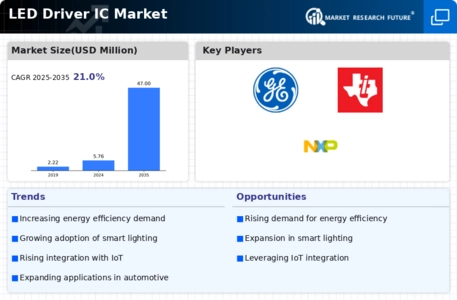Top Industry Leaders in the LED Driver IC Market

The Competitive Landscape of the LED Driver IC Market
Across dazzling cityscapes, humming industrial zones, and cozy living rooms, a silent conductor orchestrates the symphony of light – the LED Driver IC. This dynamic market pulsates with the competitive energy of players vying for control over these miniature maestros of luminescence. Unveiling the strategies, crucial factors, and overall landscape of this intricate market is vital for navigating its currents and securing a commanding position.
Some of the LED Driver IC companies listed below:
- SAMSUNG ELECTRONICS CO. LTD
- TOSHIBA CORPORATION
- GENERAL ELECTRIC
- PHILLIPS LIGHTING HOLDING B.V.
- OSRAM LICHT AG
- TEXAS INSTRUMENTS
- MITSUBISHI ELECTRIC CORPORATION
- RENESAS ELECTRONICS CORPORATION
- ANALOG DEVICES, INC.
- INFINEON TECHNOLOGIES AG
- SIEKO EPSON CORPORATION
- SEOUL SEMICONDUCTOR CO., LTD.
- NXP SEMICONDUCTORS
- ON SEMICONDUCTOR CORPORATION
- STMICROELECTRONICS N.V
- TAIWAN SEMICONDUCTOR MANUFACTURING COMPANY LIMITED
- ROHM CO., LTD
Strategies Adopted by Leaders:
- Technological Prowess: Texas Instruments and Maxim Integrated Products lead the charge with advanced LED driver ICs boasting high efficiency, dimming capabilities, and integrated safety features, catering to demanding needs across diverse lighting applications.
- Vertical Specialization: On Semi and NXP Semiconductors focus on specific segments like automotive lighting or industrial lighting, achieving unmatched expertise and cost-effectiveness within their chosen domains.
- Focus on Integration and Module Solutions: Infineon Technologies and ROHM Semiconductor offer pre-packaged driver modules with integrated control features, protection circuits, and thermal management, simplifying design and accelerating product development for customers.
- Dimming and Smart Lighting Capabilities: Companies like Analog Devices and STMicroelectronics offer drivers enabling smooth dimming, color tuning, and connectivity with smart home systems, catering to the growing demand for dynamic and intelligent lighting solutions.
- Partnerships and Collaboration: Open standards and interoperability are key, with players like the Alliance for Solid-State Lighting (ASSLED) forging collaborations to ensure device compatibility and expand market reach.
Critical Factors for Market Share Analysis:
- Efficiency and Power Factor: Companies offering drivers with minimal energy loss and a high power factor command premium prices and secure market share by reducing operating costs and contributing to energy-efficient lighting solutions.
- Dimming Range and Smoothness: Drivers enabling flicker-free dimming across a wide range, particularly for low light levels, are crucial for ensuring user comfort and catering to specific application requirements like medical facilities or theater lighting.
- Safety and Reliability: Robust protection features against surges, overheating, and short circuits are essential for safety and long-term performance, particularly in critical applications like emergency lighting or industrial settings.
- Form Factor and Design Flexibility: Compact drivers with flexible package options enable smaller and sleeker lighting designs, particularly important for consumer electronics and architectural lighting applications.
- Cost-Effectiveness and Affordability: Balancing advanced functionalities with an attractive price point is crucial for capturing market share, particularly in price-sensitive segments like outdoor lighting or large-scale installations.
New and Emerging Companies:
- Startups like Silicon Labs and Qorvo: These innovators focus on developing next-generation GaN (Gallium Nitride) based LED driver ICs offering superior efficiency, high-frequency switching, and reduced thermal dissipation, opening doors for more compact and powerful lighting solutions.
- Academia and Research Labs: Stanford University's Energy Resources Engineering Department and MIT's Plasma Science and Fusion Center explore disruptive technologies like micro-LED driver ICs for next-generation displays and organic light-emitting diode (OLED) lighting, shaping the future of solid-state illumination.
- Material Science Companies: Dow Chemical and DuPont invest heavily in R&D for advanced substrates and packaging materials enabling drivers with improved thermal management, enhanced durability, and environmental sustainability.
Latest Company Updates:
Apr. 06, 2023- ROHM Semiconductor announced new 4ch/6ch LED driver ICs enabling lower power consumption in automotive displays. These LED driver ICs, BD83A04EFV-M, BD83A14EFV-M, and BD82A26MUF-M, are designed for medium- to large-size automotive displays in-car infotainment and instrument clusters. Built-in DC and PWM dimming support a wide range of design requirements.
Feb.21, 2023- Macroblock announced the development of two new LED driver ICs, MBI6659Q and MBI6665Q, that can be used in automotive lighting. The new LED driver ICs are used in automotive interior/exterior lighting and have obtained AEC (Automotive Electronics Council)-Q100 certification for the two models.
Jan.19, 2023- Nichia Corporation and Infineon Technologies AG launched the industry's first fully integrated micro-LED matrix solution, µPLS light engine, for high-definition (HD) adaptive driving beam applications. In 2020, Infineon and Nichia announced the joint development of a high-definition (HD) light engine with more than 16,000 micro-LEDs for headlight applications. It has been a success.
Jan.05, 2023- Macroblock showcased its LED driver technologies at the Consumer Electronics Show (CES) 2023. The exhibits included LED headlights, rear lights, and Full Array Local Dimming (FALD) LED backlight modules of the in-vehicle display. Macroblock is actively developing in new fields and has recently begun to harvest in the automotive market. Major international manufacturers have successively adopted Macroblock's LED automotive driver ICs to enhance brand visibility.
July 04, 2019- Diodes Inc. introduced a new IC, the AL5814Q, for LEDs in automotive applications. Automotive-compliant, the new led driver-controller is AEC-Q100 Grade 1 qualified, and it features low dropout voltage and enhanced dimming.
The new AL5614Q is an adjustable linear LED controller with an input voltage range of 4.5 to 60 volts. This device supplies a maximum of 15 mA of drive current and uses an external LED driving power device, like a MOSFET or BJT.
